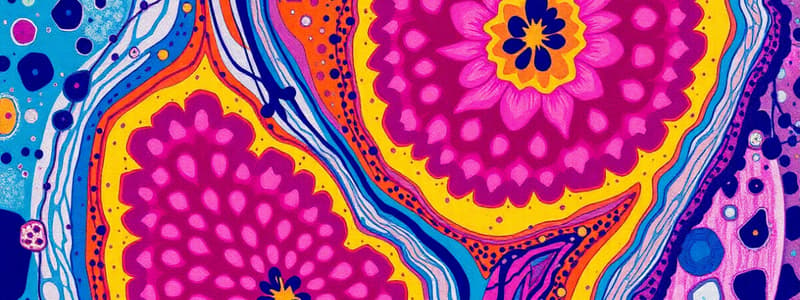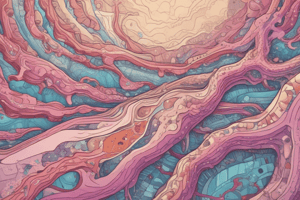Podcast
Questions and Answers
What is histology?
What is histology?
Histology is the study of the arrangement and constituent of tissues in the body.
What are the two interacting components of tissues?
What are the two interacting components of tissues?
- Both A and B (correct)
- Extracellular Matrix (ECM)
- Neither A nor B
- Cells
What does fixation do to tissue?
What does fixation do to tissue?
- Introduces paraffin
- Removes alcohol
- Cross-links proteins and inactivates degradative enzymes (correct)
- Removes water
What is the purpose of dehydration in tissue processing?
What is the purpose of dehydration in tissue processing?
What is clearing in the context of preparing a sample?
What is clearing in the context of preparing a sample?
What is infiltration in tissue processing?
What is infiltration in tissue processing?
What is H&E staining?
What is H&E staining?
Basophilic structures attract basic dyes and are positively charged.
Basophilic structures attract basic dyes and are positively charged.
Acidophilic components such as proteins stain more readily with:
Acidophilic components such as proteins stain more readily with:
What does immunohistochemistry use?
What does immunohistochemistry use?
What does immunofluorescence use?
What does immunofluorescence use?
What does scanning electron microscopy capture?
What does scanning electron microscopy capture?
What are artifacts in the context of histology slides?
What are artifacts in the context of histology slides?
What are the four basic tissue types?
What are the four basic tissue types?
Which of the following is a characteristic of epithelial tissues?
Which of the following is a characteristic of epithelial tissues?
Epithelial tissues are highly vascularized.
Epithelial tissues are highly vascularized.
What cell junction seals adjacent cells to one another and controls molecules passage between them?
What cell junction seals adjacent cells to one another and controls molecules passage between them?
What is the major transmembrane link protein that mediates hemidesmosome?
What is the major transmembrane link protein that mediates hemidesmosome?
Why tight junctions (zonula occludens) considered protection and filtration of large molecules?
Why tight junctions (zonula occludens) considered protection and filtration of large molecules?
State function of microvilli?
State function of microvilli?
Describe microvilli?
Describe microvilli?
State differences of Primary cilium and Motile Cilia/Typical Cilia?
State differences of Primary cilium and Motile Cilia/Typical Cilia?
What is the cause of bollous pemphigoid?
What is the cause of bollous pemphigoid?
Which of the following is unique to stratified epithelia of the skin and certain parts of oral cavity?
Which of the following is unique to stratified epithelia of the skin and certain parts of oral cavity?
Name location (in epithelial cells and the body) of Transitional Epithelium?
Name location (in epithelial cells and the body) of Transitional Epithelium?
Define the origin of mesenchyme?
Define the origin of mesenchyme?
Name the 3 major types of Fibers that form Fibroblasts?
Name the 3 major types of Fibers that form Fibroblasts?
Flashcards
Histology
Histology
Study of tissue arrangement and components for optimized function.
Tissue Components
Tissue Components
Cells and extracellular matrix (ECM).
Extracellular Matrix
Extracellular Matrix
Collagen, elastic, and reticular fibers; ground substance; fluids.
Tissue Processing Steps
Tissue Processing Steps
Signup and view all the flashcards
Fixation
Fixation
Signup and view all the flashcards
Dehydration
Dehydration
Signup and view all the flashcards
Clearing
Clearing
Signup and view all the flashcards
Infiltration
Infiltration
Signup and view all the flashcards
Embedding
Embedding
Signup and view all the flashcards
Trimming
Trimming
Signup and view all the flashcards
Microtome
Microtome
Signup and view all the flashcards
H&E Stain
H&E Stain
Signup and view all the flashcards
Hematoxylin
Hematoxylin
Signup and view all the flashcards
Eosin
Eosin
Signup and view all the flashcards
Histochemistry
Histochemistry
Signup and view all the flashcards
Immunohistochemistry
Immunohistochemistry
Signup and view all the flashcards
Immunofluorescence
Immunofluorescence
Signup and view all the flashcards
Light Microscopy
Light Microscopy
Signup and view all the flashcards
Electron Microscopy
Electron Microscopy
Signup and view all the flashcards
Epithelial Tissue
Epithelial Tissue
Signup and view all the flashcards
Epithelial
Epithelial
Signup and view all the flashcards
Connective
Connective
Signup and view all the flashcards
Muscle
Muscle
Signup and view all the flashcards
Nervous
Nervous
Signup and view all the flashcards
Epithelial Cell Junctions
Epithelial Cell Junctions
Signup and view all the flashcards
Tight Junction
Tight Junction
Signup and view all the flashcards
Adherent Junction
Adherent Junction
Signup and view all the flashcards
Desmosome
Desmosome
Signup and view all the flashcards
Basement membrane
Basement membrane
Signup and view all the flashcards
Gap Jnctions
Gap Jnctions
Signup and view all the flashcards
Study Notes
- These study notes cover human histology, including basic tissues, microscopy, and cellular components.
- They were made for medical laboratory science students.
Histology and Tissue Components
- Histology is the study of tissues, their arrangement, and their function in the body.
- Tissues are composed of cells and the extracellular matrix (ECM).
- Cells can have various functions like covering, absorption, secretion, and lining cavities.
- The ECM contains fibers (collagen, elastic, reticular), ground substance (GAG, proteoglycans, glycoproteins), and fluids.
- Tissues differ in cell type, ECM proportion, and tissue organization.
Histotechniques and Tissue Processing
- Histotechniques involve tissue acquisition and processing for microscopic study.
- Tissue acquisition methods include cytological swabs, biopsies, and surgical resections.
- Tissue processing generally involves:
- Fixation to preserve structure.
- Dehydration to remove water (using alcohol solutions).
- Clearing to remove alcohol and make tissue miscible with paraffin (using xylene).
- Infiltration with melted paraffin.
- Embedding in a paraffin block.
- Trimming the block for sectioning, which includes cutting in the microtome.
- Sectioning (slicing) in the microtome is also a stage.
- Staining (e.g., H&E) to visualize structures.
- Mounting on slides.
- Labelling.
Staining Methods
- Hematoxylin & Eosin (H&E) is a common dye combination.
- Hematoxylin (basic dye) stains acidic structures (DNA, RNA) blue (basophilic).
- Eosin (acidic dye) stains basic structures (cytoplasmic proteins) pink (acidophilic).
- Histochemistry uses natural chemical interactions between tissues and chemicals.
- Trichrome stains are used to visualize collagen.
- Periodic Acid Schiff (PAS) stains carbohydrates magenta.
Immunohistochemistry and Immunofluorescence
- Immunohistochemistry uses specific antigen-antibody interactions.
- A primary antibody binds to the target protein (antigen).
- A secondary antibody, with a chromogen, binds to the primary antibody.
- Immunofluorescence is similar but uses a fluorescent-tagged secondary antibody.
- Fluorescence is visualized under UV light.
- Direct methods tag the primary antibody directly.
- Indirect methods use an unlabeled primary antibody and a labeled secondary antibody.
Microscopy
- Microscopy allows observation of prepared tissue slides at various magnifications.
- Light microscopy uses natural light to illuminate the tissue.
- Light microscopy is used with histochemistry, immunochemistry, and immunofluorescence.
- All the types of light microscopy are based on the interaction of light with tissue components
Types of Light Microscopy include:
- Brightfield.
- Dark Field.
- Phase contrast.
- Polarizing.
- Fluorescence.
- Confocal.
Light Microscope Parts include:
- Eyepieces (ocular lens).
- Objective lenses.
- Head.
- Arm (frame).
- Stage controls.
- Coarse/fine adjustment knobs.
- Diopter adjustment.
- Nose piece.
- Stage clip.
- Mechanical stage.
- Aperture.
- Brightness adjustment.
- Condenser.
- Illumination.
- Light switch.
- Base.
Microscope Lenses
- The condenser collects and focuses light.
- Objective lenses enlarge and project the image. –Common magnifications: 4x, 10x, 40x.
- Eyepieces (oculars) further magnify the image (typically 10x).
- Total magnification is the product of objective and eyepiece magnification.
Other Microscopy Techniques
- Phase contrast microscopy uses refractive properties; good for live cells.
- Fluorescence microscopy requires fluorescent dyes and a UV light source.
- Confocal microscopy uses a laser and pinhole aperture for optical sectioning and 3D reconstruction.
- Electron microscopy uses electron beams for higher magnification and resolution.
Electron Microscopy Types include:
- Scanning Electron Microscopy (SEM): Captures surface contours.
- Transmission Electron Microscopy (TEM): Electrons pass through tissue, casting different shades depending on electron density.
Interpreting Images
- Darker areas in TEM indicate electron-dense, concentrated tissue.
- Lighter areas in TEM indicate less dense tissue.
- Artifacts are a natural part of histology.
- Histological images are 2D representations of 3D structures.
- Virtual microscopy uses software to simulate a microscope on a digital screen.
Basic Tissue Types and Epithelial Tissue
- The four basic tissue types are:
- Epithelial.
- Connective.
- Muscle.
- Nervous.
- Epithelial tissue consists of aggregated polyhedral cells with a small amount of ECM.
Epithelial tissue has the following main functions:
- Lining surfaces/cavities, and glandular secretion.
- Cells of epithelial tissue has the following properties:
- Variable shapes/dimensions.
- Nuclei reflect cell shape.
- Avascular.
- High mitotic index.
- Polarity (apical, basal).
- Lateral surfaces with folds to increase area.
Epithelial Tissue Types
- Simple: One cell layer.
- Stratified: Multiple layers.
- Pseudostratified: Appears layered but all cells contact the basement membrane.
- Cell shapes: squamous, cuboidal, columnar.
- Specializations: ciliated, keratinized.
Epithelial Cell Junctions include:
- Tight junctions (zonula occludens): Seal cells together to control passage of molecules.
- Adherens junctions (zonula adherens): Link cytoskeleton, strengthen tight junctions.
- Desmosomes (macula adherens): Strong intermediate filament coupling.
- Hemidesmosomes: Anchor cytoskeleton to basal lamina.
- Gap junctions (nexus): Allow direct transfer of small molecules/ions.
Apical Cell Surface Specializations include:
- Microvilli: Increase surface area.
- Cilia: Move substances along the surface.
- Stereocilia: For absorption or sensory function.
Basement Membrane is what the basal surface of all epithelia rests on:
- Provides support.
- Acts like a filter.
- Components:
- Basal lamina.
- Reticular lamina.
- It is capable of epithelial repair and regeneration.
Studying That Suits You
Use AI to generate personalized quizzes and flashcards to suit your learning preferences.
Related Documents
Description
Explore human histology, covering tissues and microscopy. Learn about tissue components, cells, and ECM. Understand histotechniques and tissue processing for medical laboratory science students.




